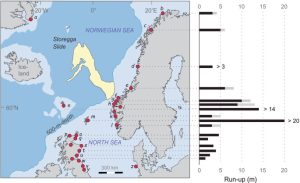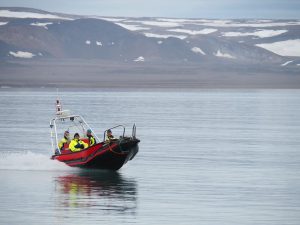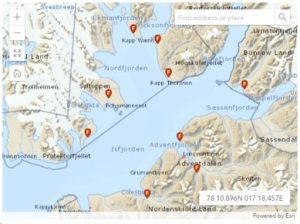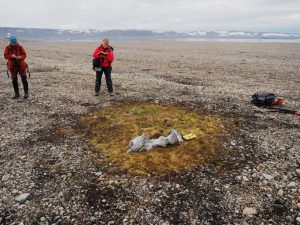Important: interested applicants must take contact before July 3rd 2023.
Research question
Can the famous Storegga Tsunami, that occured around 8.1 cal ka BP, be identified for the first time in Svalbard in the raised marine sediments and geomorphology of Isfjorden?If so, how extensive was the tsunami here, what role did sea ice play and what marine and climate conditions persisted at the time?What implications does this have for the future submarine landslide tsunami risk in Svalbard?RiS Project Number 12223
Project description
Though of low occurrence frequency, extreme events such as storm surges and submarine landslide-induced tsunamis have (pre)historically resulted in significant coastal flooding, infrastructure damage and loss of life around the European margins of the Atlantic, including the North, Norwegian and Baltic seas. In particular the Storegga Tsunami, initiated by several submarine failures on the edge of Norway’s continental shelf 100 km north-west of the Møre coast 8120-8175 cal yrs BP, resulted in major inundation along the coasts of Norway, Iceland, Faeroe, and Scotland. Glacial sediment overloading of the continental shelf and slope is considered the primary cause of the slide, though climate change and gas hydrate destabilisation are also implicated. With run-up above contemporaneous sea level between 5 and >20 m along northern North Sea and Norwegian Sea coasts, the tsunami has been implicated in the final demise of Doggerland – inhabited low-lying islands in the North Sea subject to mid Holocene sea level rise. Latest work has identify Storegga Tsunami deposits as far afield as eastern Greenland, norther Finmark (Norway), and the Kola Peninsula (Russia). The concentration of infrastructure and populations along these coasts today would mean a modern equivalent event would be catastrophic. With multiple glacially deposited trough mouth fans along the North Atlantic and Arctic Ocean margins, the potential for future major tsunami-inducing failures remains.
In particular the Storegga Tsunami, initiated by several submarine failures on the edge of Norway’s continental shelf 100 km north-west of the Møre coast 8120-8175 cal yrs BP, resulted in major inundation along the coasts of Norway, Iceland, Faeroe, and Scotland. Glacial sediment overloading of the continental shelf and slope is considered the primary cause of the slide, though climate change and gas hydrate destabilisation are also implicated. With run-up above contemporaneous sea level between 5 and >20 m along northern North Sea and Norwegian Sea coasts, the tsunami has been implicated in the final demise of Doggerland – inhabited low-lying islands in the North Sea subject to mid Holocene sea level rise. Latest work has identify Storegga Tsunami deposits as far afield as eastern Greenland, norther Finmark (Norway), and the Kola Peninsula (Russia). The concentration of infrastructure and populations along these coasts today would mean a modern equivalent event would be catastrophic. With multiple glacially deposited trough mouth fans along the North Atlantic and Arctic Ocean margins, the potential for future major tsunami-inducing failures remains. This project seeks to identify and explore the extent of Storegga Tsunami impact on the coast of Svalbard, hitherto unidentified despite the archipelago’s position within the zone of wave influence as identified from other locations. Concentrating on Isfjorden, where bathymetry and coastal orientation would favour amplification of the wave’s amplitude and enhance run-up, the project will directly examine coastal sediments and landforms at key lowland sites to recover and identify radio carbon dated sediments. This will permit the reconstruction of Storegga Tsunami impacts and meaningful modelling and assessment of the hazards that future similar or larger magnitude tsunami events pose to settlements and infrastructure in Isfjorden. Further, this work will also further resolve previous poorly constrained records of Holocene sea level change around Isfjorden as well as generating additional information on marine and climatic conditions pertaining during the Holocene – a period generally considered warmer than present and a potential analogue for a future warmer Svalbard.
This project seeks to identify and explore the extent of Storegga Tsunami impact on the coast of Svalbard, hitherto unidentified despite the archipelago’s position within the zone of wave influence as identified from other locations. Concentrating on Isfjorden, where bathymetry and coastal orientation would favour amplification of the wave’s amplitude and enhance run-up, the project will directly examine coastal sediments and landforms at key lowland sites to recover and identify radio carbon dated sediments. This will permit the reconstruction of Storegga Tsunami impacts and meaningful modelling and assessment of the hazards that future similar or larger magnitude tsunami events pose to settlements and infrastructure in Isfjorden. Further, this work will also further resolve previous poorly constrained records of Holocene sea level change around Isfjorden as well as generating additional information on marine and climatic conditions pertaining during the Holocene – a period generally considered warmer than present and a potential analogue for a future warmer Svalbard.
 The project involves: Initial fieldwork will be characterised by terrestrial surveys of six key sites in central and inner Isfjorden – Erdmannflya, Bohemanflya, Blomesletta, Kapp Wijk, Kapp Thordsen/Sauriedalen, and Gipsdalen (with three back-up sites around Longyearbyen – Revneset, outer Adventdalen, Colesbukta). Calibrated sea level curves will identify the 8.1 cal ka BP shoreline, which will be walked to identify subtle sediments and landforms associated with tsunami run-up. Sediments will be recovered by hand auger and surface collection. Chronology will be based on radiocarbon-dating surface and exposure collections of subfossil marine molluscs, driftwood, and subfossil cetacean remains. Dunsappietjørna (Gipsdalen) will also be cored to recover lake floor sediments given its close relationship to the shoreline at the time of the Storegga Tsunami.This project’s successful identification of the Storegga event in Isfjorden will form the basis of a subsequent larger grant proposal to explore the impacts of the event further afield around Svalbard, including modelling wave propagation and examining the risk to modern Svalbard infrastructure.
The project involves: Initial fieldwork will be characterised by terrestrial surveys of six key sites in central and inner Isfjorden – Erdmannflya, Bohemanflya, Blomesletta, Kapp Wijk, Kapp Thordsen/Sauriedalen, and Gipsdalen (with three back-up sites around Longyearbyen – Revneset, outer Adventdalen, Colesbukta). Calibrated sea level curves will identify the 8.1 cal ka BP shoreline, which will be walked to identify subtle sediments and landforms associated with tsunami run-up. Sediments will be recovered by hand auger and surface collection. Chronology will be based on radiocarbon-dating surface and exposure collections of subfossil marine molluscs, driftwood, and subfossil cetacean remains. Dunsappietjørna (Gipsdalen) will also be cored to recover lake floor sediments given its close relationship to the shoreline at the time of the Storegga Tsunami.This project’s successful identification of the Storegga event in Isfjorden will form the basis of a subsequent larger grant proposal to explore the impacts of the event further afield around Svalbard, including modelling wave propagation and examining the risk to modern Svalbard infrastructure.
Starting date/period: Jul 31, 2023 – Aug 08, 2023
Involvement
The student field assistant would accompany the other expedition members (M. Furze, UNIS; W. Szczuciński, UAM Poznań; and others) on the day trips in Isfjorden by PolarCirkel to the field sites. With Furze and Szczuciński, the field assistant would help with the following activities: cleaning up soft sediment geological exposures with shovel and trowel; describing and measuring sediment exposures; recover sediments from the ground with a hand auger; sample sub-fossil marine molluscs, drift wood, and marine mammal remains from raised beaches for radiocarbon dating; recover sediment cores from a lake from a coring rig deployed from inflatable raft, carry heavy coring equipment 4 km into the lake and back out again.
Experience/skills to be acquired
The student will gain experience in coastal and tsunami field geomorphology and stratigraphy. They will develop field note taking skills along with practical experience in cleaning and describing sedimentary sections, field sampling protocols, and using a variety of lake coring systems to recover geological samples. By direct observation in the field, they will also develop an understanding of Arctic sea-level change driven by glacio-isostatic rebound and ocean volume changes, as well as changing Holocene climate.
PrerequisitesThe successful applicant should be physically fit and be prepared to carry heavy backpacks of equipment in excess of 10 km each day for a sustained 6 day period. They should have an interest in Arctic environmental change, sea level, and Quaternary geology, sedimentology, and geomorphology. Previous experience in UNIS Arctic Geology courses in Physical Geography or Quaternary Geology such as AG-204, AG-210, AG-220, or AG-221 is desirable but not necessary. Ability and license to carry a rifle is also required. A good sense of humour is essential.
Interested in this project or need more info? Contact Mark Furze (markf@unis.no) before July 3rd, 2023
Project number: 29

